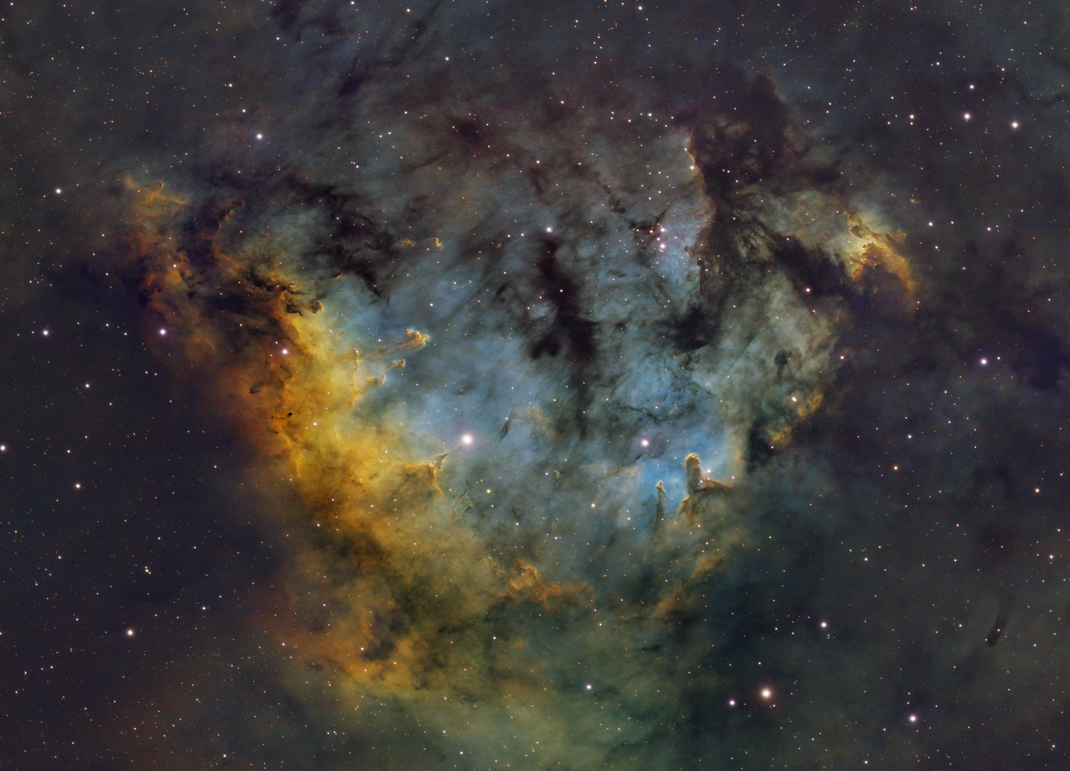Cederblad 214 in SHO (Hubble Palette)
Characteristics:
RA (J2000): 00h 03m 35s
Dec (J2000): +67 degrees 09' 42"
Position Angle: 0 degrees
Description:
This
is a narrowband image comprised of data from SII (Red channel), Ha
(Green channel), and OIII (Blue channel) filters, referred to as the
"Hubble Palette". Cederblad
214 (Ced214), also known as Sharpless 171 (SH2-171), is a large
emission nebula in the constellation Cepheus. Within
Ced214 there are many
regions of "elephant trunk" structures created as a result of gas being
blown away by UV radiation from one of the brightest UV sources in the
nebula, the star BD+66 1673 (J2000
coordinates for BD+66
1673 are RA 00 01 47; Dec +67 30 25), which is contained
within a cluster of about 40 hot, short-lived OB stars known
as the Berkeley 59 complex (Be59) located just to the right and above
center in this field. As
can be appreciated by the "donut hole" in the central part
of this complex (which shines in higher energy blue light from OIII
emission), gas in this star-forming region is being cleared out
by
the young, newly formed stars of the Berkeley 59 complex, which emit
strong UV radiation, reminiscent of
similar nebulae such as IC1396 and
the Rosette.
More information about this interesting region may be found on Rob
Gendler's webpage,
and on the APOD
website. Please be sure to check out the higher resolution
views of this region in the links above, as well as my previous
narrowband image
of a wider
field that includes NGC7822.
Photographic
Details:
Dates: September 19 and 20,
2023.
Scope: Takahashi
FSQ106 at f5 on the Takahashi NJP
Mount.
Autoguider: ASI178 autoguider with SvBony 30mm guidescope, focal length
120mm.
Camera: ZWO ASI294MM at -10C,
with
7 position ZWO filter wheel. Pixel size is 2.3 microns (Bin 1x1),
yielding an image scale with the FSQ (530mm focal length) of 0.90
"/pixel (well matched for my seeing of 3 arcseconds).
Camera gain set to 50 (e-gain
2.13 electrons/ADU), offset 25.
Read noise at this gain level was 2.18 electrons rms.
Filters: Baader
Ha, OIII, and SII filters; 2 inch.
Image acquisition
software: MaximDL for camera control and autoguiding; CCD
Commander for automation.
Exposures: Total
exposure 10 hours (Ha: 4 hours, 300 second subs; OIII: 3 hours, 300
second subs; SII: 3 hours, 300 second subs).
Processing:
Calibration,
integration, deconvolution (BlurXTerminator), noise reduction
(NoiseXTerminator), and Narrowband Normalization (Bill Blanshan and Mike Cranfield
Pixinsight process) in
Pixinsight; subsequent processing in Photoshop.
Please
note: Graphics on this website may not be reproduced without
author permission.
Back to Nebulae
Home



